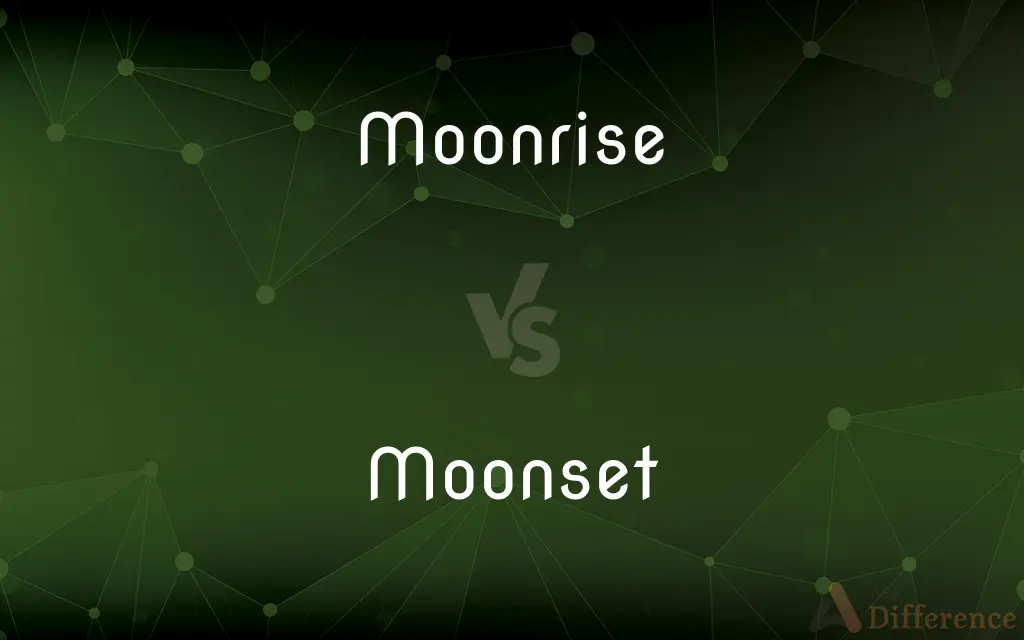Moonrise vs. Moonset — What's the Difference?
By Tayyaba Rehman & Urooj Arif — Updated on March 20, 2024
Moonrise refers to the moment the moon appears above the horizon, while moonset is when it descends below the horizon.

Difference Between Moonrise and Moonset
Table of Contents
ADVERTISEMENT
Key Differences
Moonrise is the event occurring when the moon becomes visible as it ascends above the Earth's horizon, marking the beginning of its presence in the sky for that particular cycle or night. On the other hand, moonset is the counterpart event, happening when the moon descends and disappears below the horizon, concluding its visibility for that cycle or night.
While moonrise signifies the start of the moon being visible in the sky, often leading to various phases of moonlight throughout the night, moonset indicates the end of this visibility, transitioning the sky from moonlit to its moonless state until the next moonrise. These events are influenced by the moon's orbit around Earth, Earth's rotation, and the observer's geographical location.
The timing of moonrise and moonset can vary significantly from one day to the next due to the moon's elliptical orbit and its inclination to the Earth's equator. This variance contrasts with the more regular pattern of sunrise and sunset. As a result, moonrise might occur at different times of the night or day, just as moonset can, reflecting the dynamic nature of the lunar cycle.
Observing moonrise and moonset can offer unique experiences; moonrise, especially during a full moon, can be a dramatic spectacle as the moon appears larger and often tinged with color near the horizon due to atmospheric effects. Moonset, while perhaps less celebrated, can also provide serene and picturesque moments as the moon slowly dips below the horizon, often in the early morning hours.
Comparison Chart
Definition
The moment the moon appears above the horizon.
The moment the moon disappears below the horizon.
ADVERTISEMENT
Significance
Marks the beginning of the moon's visibility in the sky.
Indicates the end of the moon's visibility until the next moonrise.
Variability
Timing can vary greatly due to the moon's orbit and Earth's rotation.
Similarly variable, influenced by the same astronomical factors as moonrise.
Observational Experience
Often associated with the dramatic appearance of the moon, especially during full moon phases.
Can provide tranquil and picturesque moments, particularly noticeable in the early morning.
Influence
Affects the night's light conditions, contributing to the phases of moonlight.
Marks the transition to a moonless sky, affecting ambient night light conditions.
Compare with Definitions
Moonrise
The occurrence of the moon becoming visible above the Earth's horizon.
We watched the moonrise from the beach, as the moon slowly appeared over the ocean.
Moonset
The event when the moon goes below the Earth's horizon, ending its visibility.
Early risers can often catch the serene moment of the moonset.
Moonrise
The start of the moon's visibility in a given night or lunar cycle.
The moonrise brought a soft glow to the otherwise dark landscape.
Moonset
Influences tides, fishing, and other maritime activities.
Fishermen timed their return to coincide with the moonset for favorable tides.
Moonrise
A significant event for various cultural rituals and activities.
The festival began with the moonrise, as per tradition.
Moonset
Concludes the period of moonlight for that night or lunar cycle.
As moonset approached, the landscape fell into complete darkness.
Moonrise
Can vary in timing and appearance due to atmospheric conditions.
The moonrise was particularly beautiful, with the moon appearing red as it ascended.
Moonset
Can be a peaceful and picturesque scene, especially in clear conditions.
The moonset over the mountains created a stunning silhouette.
Moonrise
Marks the phase when nocturnal wildlife becomes more active.
With the moonrise, we could hear the night creatures stirring.
Moonset
Marks a transition period in many ecosystems, affecting animal behavior.
As the moonset neared, the nocturnal animals began to seek shelter.
Moonrise
The event or time of the appearance of the upper circumferential edge of the moon as it rises above the horizon.
Moonset
The event or time of the disappearance of the moon's upper circumferential edge as it sets below the horizon.
Moonrise
The time of day or night when the moon begins to rise over the horizon.
Moonset
The setting of the moon below the horizon
Moonrise
The rising of the moon above the horizon; also, the time of its rising.
Moonset
The descent of the moon below the horizon; also, the time when the moon sets.
Common Curiosities
Why does the timing of moonrise and moonset change daily?
The timing changes due to the moon's elliptical orbit around Earth and its inclination to the Earth's equator, leading to a roughly one-hour difference each day.
Is moonrise always in the east and moonset in the west?
Generally, moonrise occurs in the eastern part of the sky and moonset in the western part, but the exact locations can vary with the seasons and the observer's latitude.
How does the phase of the moon affect moonrise and moonset?
The moon's phase affects the timing; for example, during a full moon, moonrise occurs around sunset, and moonset occurs around sunrise.
Can moonrise and moonset occur during the day?
Yes, both moonrise and moonset can occur during daylight hours, depending on the lunar cycle and the observer's location.
Why does the moon sometimes appear larger during moonrise?
This is due to the moon illusion, a perceptual phenomenon where the moon appears larger near the horizon than it does higher in the sky, partly due to atmospheric effects and perspective.
Do moonrise and moonset have cultural or religious significance?
In many cultures and religions, moonrise and moonset, along with the lunar cycle, play important roles in festivals, rituals, and calendars.
What is the best way to observe moonrise or moonset?
A clear view of the horizon, away from city lights and obstructions, enhances the experience of observing moonrise and moonset.
How do atmospheric conditions affect the appearance of moonrise and moonset?
Atmospheric conditions like humidity, dust, and pollution can affect the color and clarity of the moon during moonrise and moonset, often resulting in red or orange hues.
Do moonrise and moonset affect wildlife behavior?
Yes, the presence or absence of moonlight during moonrise and moonset can influence the behavior of many nocturnal animals.
Can moonrise and moonset times be predicted accurately?
While approximate times can be predicted, local topography and atmospheric conditions can slightly alter the observed times of moonrise and moonset.
Share Your Discovery

Previous Comparison
Continue vs. Follow
Next Comparison
Cutlet vs. RissoleAuthor Spotlight
Written by
Tayyaba RehmanTayyaba Rehman is a distinguished writer, currently serving as a primary contributor to askdifference.com. As a researcher in semantics and etymology, Tayyaba's passion for the complexity of languages and their distinctions has found a perfect home on the platform. Tayyaba delves into the intricacies of language, distinguishing between commonly confused words and phrases, thereby providing clarity for readers worldwide.
Co-written by
Urooj ArifUrooj is a skilled content writer at Ask Difference, known for her exceptional ability to simplify complex topics into engaging and informative content. With a passion for research and a flair for clear, concise writing, she consistently delivers articles that resonate with our diverse audience.














































